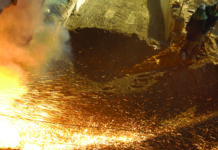
[miningmx.com] — FACED with the task of imagining the worst “inhumanity” one species could inflict upon another, director James Cameron in his feature film Avatar could turn to only one abomination: mining. Thus, as many of us saw, the unfortunate Na’vi faced the extinction of their culture as humankind raped their planet, Pandora, in search of . wait for it . unobtanium.
Painting miners as the villains is not completely unreasonable, notwithstanding vast improvements in the way miners treat the environment. Anyone who has visited a mine can’t get away from the disruption it causes. Having said that, however, the US consumes more steel per person than food, so you can’t escape the reality of modern civilisation having to mine. But I digress.
The point is that from the perspective of popular consciousness, mining is villainous. It belongs with the other smokestack activities which have their origins in the nineteenth century such as chimney sweeps, cotton milling, stuffing methane-sniffing budgies down improbably constructed coal mines, etc, etc.
Perhaps the intractably poor image of mining is a feeder reason why there’s such a chronic shortage of skills in the industry, which in turn is helping drive commodity prices up further. But more of that later.
The fact is that in modern day mining, it’s hellishly difficult to find the expertise to commission mines, which carry considerable risk. Get the project planning wrong, and your multi-billion dollar mine will never recover. Mine managers can fiddle around the edges, lowering costs a couple of percent, but once the mine is configured, it’s cast in stone. If the mine is planned badly, the company will spend the rest of the mine life paying for it, literally.
There are, of course, other reasons for the skills mining shortage. The exploration slump from the mid-1990s for a decade reduced the need for geologists in particular. Nor could the scale of metals demand, especially from China, be anticipated given the time it requires to skill up a mining professional. According to Letsema Consulting, which provides advisory services to mining companies in the arena of skills and labour, it takes eight to 10 years.
Yet for those lucky few who do hold mining engineering or geology degrees, and for those about to enter the field, life promises to be good, and lucrative. Mining professionals today stand to make a complete killing in monetary terms, owing to the sheer paucity of their numbers.
According to an article by news wire agency AFP, the average age of the mining professional – project planner, geologist or engineer – was 50, double the age a decade ago. Says Rene Marion, CEO of Canadian gold miner AuRico, mining professionals are impossible to find. Of the nine universities that produce mining graduates in Canada, there are 300 graduates this year, 700 below what’s required.
Mike Booton, who works for Dangerfield Executive Recruitment, a headhunter working in mining recruitment, says skills shortages are making it more difficult to build mines which, in turn, makes metal supply less easy to predict: “The result is wage inflation, projects pushed back, and a potential gap between supply and demand in the market creating higher prices for resources, which feeds back into wage inflation.’
Experience also matters, so training mining engineers and project planners today doesn’t mean the problem is solved tomorrow, or the day after that. “You can talk the theory of commissioning a mine,’ says Mark Tyler, co-head of resources at Nedbank Capital, “but what’s needed is very strong practical understanding and experience.’
Says Booton: “The mining world is caught in a spiral of wage inflation, resulting in the fact that a general manager of a mid-tier mining company can now expect to earn more than a Harvard MBA would after the same length of career’.
Full-time earnings in Australia average $A66,594. In financial services, banking and insurance, the traditional resort of Harvard MBAs, the average wage is $A80,000. In mining, the average wage is $A108,009, by far the highest paid sector in the Australian economy, says Booton.
Bloomberg News recently cited the example of a 24-year-old rigger who was earning $A220,000 a year – more than Ben Bernanke, chairperson of the Federal Reserve rakes in a year.
In South Africa, there’s a similar issue. Dangerfield is poaching people to work in Australia at a rate of 4:1; one South African national is placed in another company for every four assignments the company undertakes.
“The rates offered by South African companies to employ key skills we operate in have risen an average 7% this year and except for rarefied high level roles, a South African company can forget (about) trying to attract someone already working in North America, Canada or Australia,’ says Booton.
“At present, South African companies are just not able to compete with a counter offer enough to retain their employee. Even companies outside of Australia find it easier to compete in the global market by poaching a South African ex-pat to work elsewhere in Africa,’ he says.
Says Nivan Moodley of Letsema’s Mining Advisory Services: “The low participation of talent management, development and retention in the mining industry has resulted in a serious talent gap. Efforts need to be focused on attracting skilled labour to the mining industry, retaining current staff, teaming up with educational institutions to attract students and ensure the quality of graduates.’











